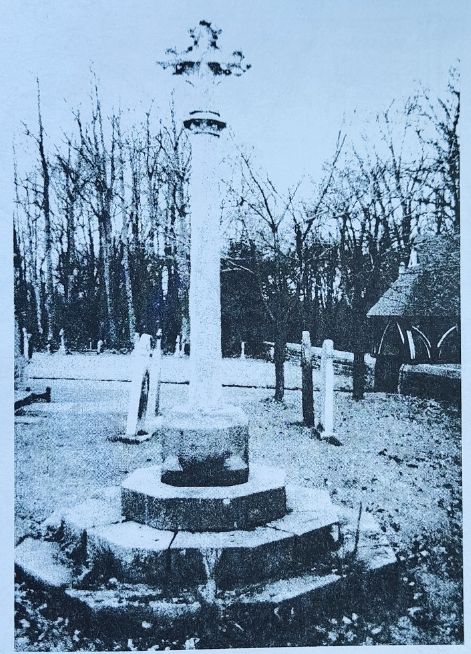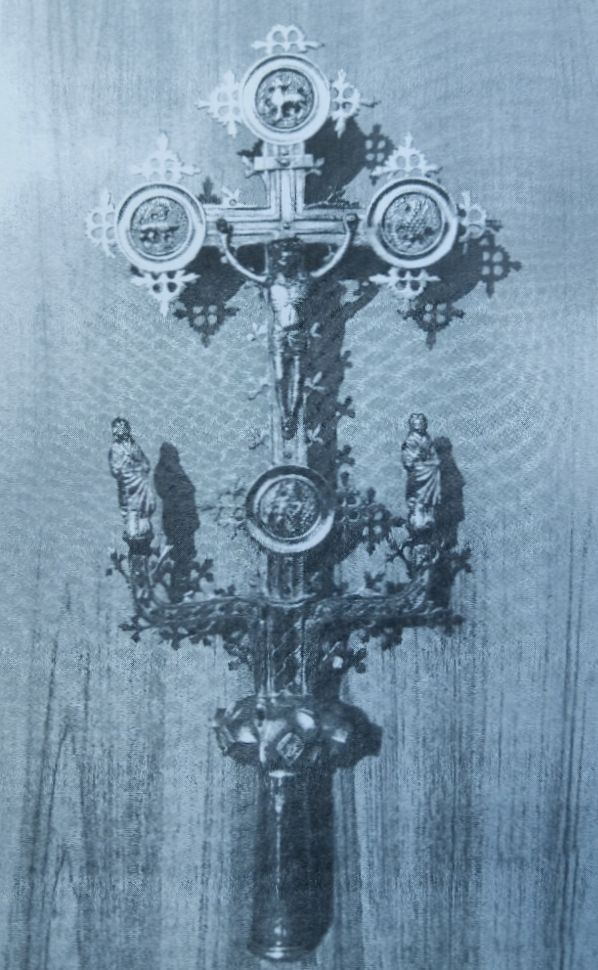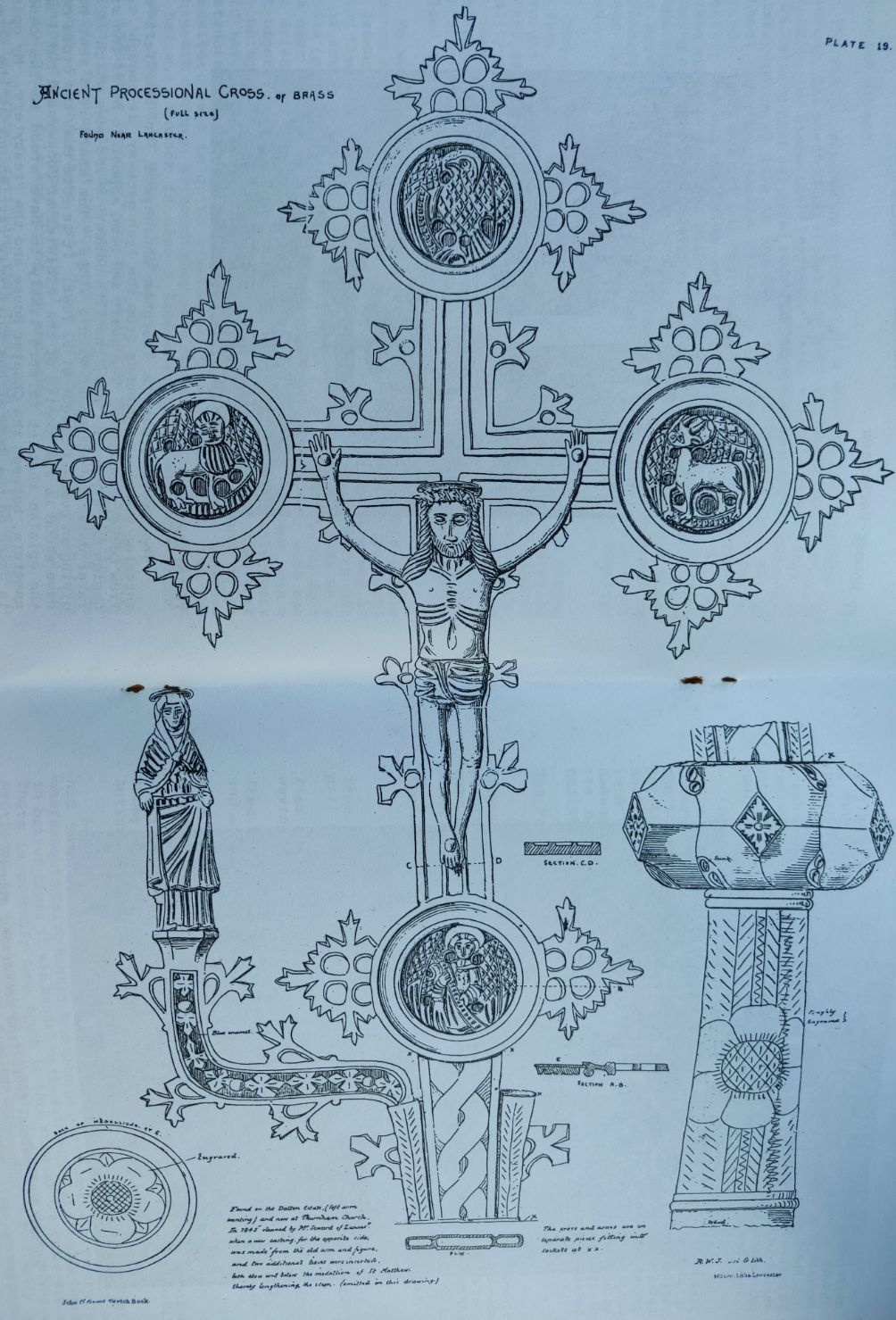The Stone Cross
The Stone Cross in Thurnham churchyard, to the left when entering the church grounds from the lych gateway, is thought to be from Cockersand Abbey. The shaft and head appear to be of the right design and style for, say, the 13th century. The base which is of a The shaft is 8 feet high, later date, is octagonal with 3 steps. giving an overall height of 12 feet. It is said that the cross could have stood in the centre of the cloister at Cockersand but I am of the opinion that it is more likely to have stood in the canon's cemetery, between the Chapter House and the Presbytery. My opinion is based on the excavations which were carried out at the Abbey in 1923-1924, where the report and plan of the excavation states that a shallow well-like depression was found in the canon's cemetery. I consider this could be the original site of the cross.8u

The whereabouts of the cross from the time of the Dissolution to 1785 is not known. The present church at Thurnham was built in 1848. (Kitchen) of Hatfield, Herts. bought the lands and buildings for £709.8s. 6d. On the marriage of his daughter Anne to Robert Dalton of Bispham near Parbold in 1554, the property passed to the Dalton family of Thurnham Hall. The cross presumably then became the property of the Dalton family and it may have been moved when a church was built at Thurnham.
The cross is listed as Grade 11. I quote the report "it is said to be probably 19th century, or possibly found on the site of Cockersand Abbey and re-erected then. Limestone with sandstone base. The base has 3 octagonal steps with an octagonal pedestal socketed for the shaft, which is also octagonal and badly weathered on the north side. Above a moulded cap is a foliated cross head." The cross
is actually very weathered on the north west side, this could be damage on account of the more acidic conditions in recent years. In its days at Cockersand it would have been in a more sheltered position.
The Processional Cross
The Cockersand Processional Cross, now in the Lancashire County Museum, Stanley Street, Preston was probably an early one. It is made of brass and copper and presumably it was later replaced by the much more elaborate one of silver plate mentioned in the inventory at the Dissolution.

"Inventory of goods and chattels at Cockersand Abbey A.D.1536".
(The beginning of the roll is torn away)
Item another Chales with the paten siluer parcell gilt weying xiiii vnces at 3s. 6d. the vnce
Item a paire of Sensers of Siluer parcell gilt weying xxviii vnces at 3s. 4d the vnce.... £4.8s. 4d
Item oon Crosse of Wodde couered with Silver plate and is worth by estymacion at 13s.4d.
Item A Crosierstaff of Coper & gilt is worth by estymacion at (Not to be given away or sold)
The above is a small extract from the Inventory of Cockersand Abbey as mentioned in the report to the "Lancashire and Cheshire Antiquarian Society 1886 by William O. Roper"

Legend has it that at the time of the Dissolution a local family bid the brass and copper cross, the secret of its location and whereabouts being handed down through generations until eventually, in better times it was handed to the safekeeping of Thurnham Church. There is probably some truth in this story as the cross was not mentioned in the Inventory, probably the reason it survived was because it was not made of precious metal. When it eventually 're- appeared' one of the side figures was missing. A new one was made in the same style.
A drawing of the cross exists showing the state it was in when found. The drawing is entitled "ANCIENT PROCESSIONAL CROSS OF BRASS".
In the lower left hand side of the drawing is a note which states:-
"Found on the Dalton Estate (left arm wanting) and now at Thurnham Church. In 1845 cleaned by Mr. Seward of Lancaster when a new casting for the opposite side was made from the old arm and figure, and two additional leaves were inserted both above and below the medallion of St. Matthew thereby lengthening the stem. (Omitted in this drawing)."
Note the difference between the drawing of 1845 and the photograph which was taken by me in 1980.
The drawing indicates that the side arms of the cross were infilled with blue enamel, there is now no sign of this. The medallions are of the four evangelists, Matthew, Mark, Luke and John and the side arms, separate pieces which fit into sockets, are figures of The Virgin Mary and Mary of Magdala.
It does seem a shame that the cross is no longer used. In my younger days I have carried the cross at Thurnham Church in services, processions and at funerals. A number of years ago, Mr. Hugh Sherdley, late president of the Pilling & District Historical Society and myself made a replacement shaft for it as the previous one had been damaged.
The cross went on loan to the County Museum some years ago and can be seen there. I quote their description:-
METALWORK: Processional cross, late 15c, of cast brass with Crucifixion and roundels showing Evangelist symbols, foliated brackets with engraved brass plates below: some restoration and repair; found on Dalton Estate, Thurnham, thought to be from Cockersand Abbey: h:660mm, w:300mm" (approx.h:26inches w: 12 inches).
Acknowledgements
I would like to thank Dr. Stephen Bull (Curator) and the staff of Lancashire County Museum for their co-operation.
